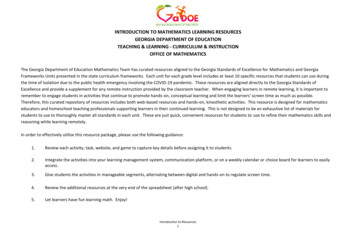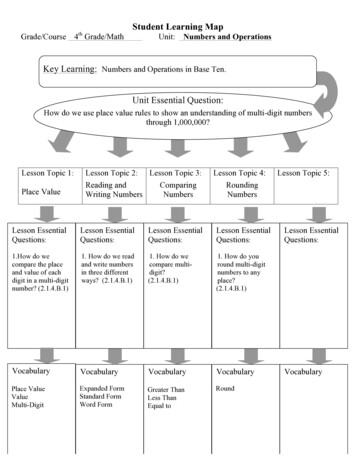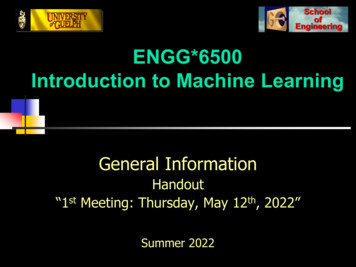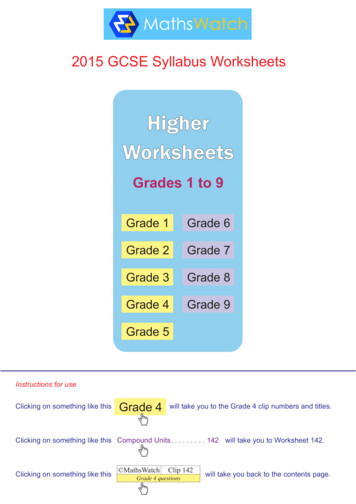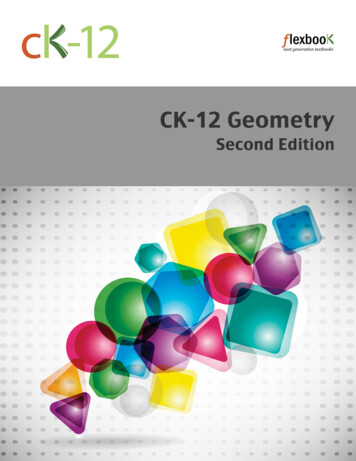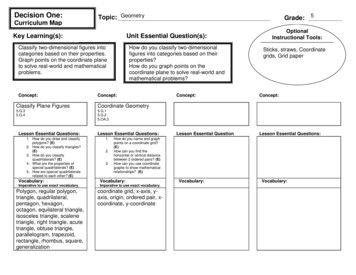
Transcription
Decision One:Curriculum MapTopic: GeometryKey Learning(s):Unit Essential Question(s):Classify two-dimensional figures intocategories based on their properties.Graph points on the coordinate planeto solve real-world and mathematicalproblems.Concept:How do you classify two-dimensionalfigures into categories based on theirproperties?How do you graph points on thecoordinate plane to solve real-world andmathematical problems?Concept:Classify Plane FiguresCoordinate Geometry5.G.35.G.45.G.15.G.25.OA.3Lesson Essential Questions:1. How do you draw and classifypolygons? (E)2. How do you classify triangles?(E)3. How do you classifyquadrilaterals? (E)4. What are the properties ofspecial quadrilaterals? (E)5. How are special quadrilateralsrelated to each other? (E)Lesson Essential Questions:1.2.3.OptionalInstructional Tools:Sticks, straws, Coordinategrids, Grid paperConcept:Concept:Lesson Essential QuestionLesson Essential Questions:How do you name and graphpoints on a coordinate grid?(E)How can you find thehorizontal or vertical distancebetween 2 ordered pairs? (E)How can you use coordinategraphs to show mathematicalrelationships? (E)Vocabulary:Vocabulary:Imperative to use exact vocabulary.Imperative to use exact vocabulary.Polygon, regular polygon,triangle, quadrilateral,pentagon, hexagon,octagon, equilateral triangle,isosceles triangle, scalenetriangle, right triangle, acutetriangle, obtuse triangle,parallelogram, trapezoid,rectangle, rhombus, square,generalizationGrade: 5coordinate grid, x-axis, yaxis, origin, ordered pair, xcoordinate, y-coordinateVocabulary:Vocabulary:
Decision One:Curriculum MapTopic: Measurement and DataKey Learning(s):Unit Essential Question(s):Geometric measurement: understandconcepts of volume and relate volumeto multiplication and addition.Convert like measurement units withina given measurement system.Represent and interpret dataConcept:Grade: 5How does volume relate to multiplicationand division?How do you convert measurement unitswithin a given measurement system?How do we represent and interpret data?Concept:Concept:Volume of SolidsUnits of 25.G.2Lesson Essential Questions:Lesson Essential Question5.MD.55.MD.5.a5.MD.5.b5.MD.5.cLesson Essential Questions:6. How do you describe a threedimensional shape or solid? (I)7. How do you describe views ofstacked cubes/solids? (I)8. How can you use models to findthe volume of a rectangularprism? (E)9. How can you find the volume ofa rectangular prism using aformula? (E)10. How do you find the volume ofan irregular solid? (I)(volume of non-overlappingfigures only)4.How do you convert customaryunits of length to another? (E)5. How do you convert units ofcapacity to another? (E)6. How do you convert betweencustomary units of weight? (E)7. How do you convert metricunits of length? (E)8. How do you convert metricunits of capacity? (E)9. How do you convert betweenmetric units of mass? (E)(conversions not immediatelyabove or below a given unit)1.2.3.4.5.6.How can you organize data in aline plot? (E)How can you display the dataand collect in a survey? (E)How can we organize andrepresent measurement data andcreate a line plot? (E)How can we solve problemsinvolving computation offractions from a line plot? (E)How do you construct variousvisual displays to represent data?(E)How do you determine anappropriate title, scale and labelfor visual displays? (E)OptionalInstructional Tools:Solid figures, Centimetercubes, Grid paper, Unitcubes, Rulers, Yardstick,Measuring cupsConcept:Lesson Essential Questions:
tive to use exact vocabulary.Imperative to use exact vocabulary.Imperative to use exact vocabulary.Imperative to use exact vocabulary.rectangular prism, volume,cubic unitsdata, frequency table, lineplot outlier, sample, survey,tally table, pictograph, bargraph, line graph, title, scale,label
Decision One:Curriculum MapTopic: Number and Operations – FractionsKey Learning(s):Unit Essential Question(s):Use equivalent fractions as a strategyto add and subtract fractions.Apply and extend previousunderstandings of multiplication anddivision to multiply and divide fractions.Concept:How do you use equivalent fractions as astrategy to add and subtract fractions?How do we apply prior knowledge ofmultiplication and division to multiply anddivide fractions?Concept:Concept:Adding and SubtractingFractionsAdding and SubtractingMixed NumbersMultiplying and DividingFractions and Mixed 4.b5.NF.5.a5.NF.5.bLesson Essential Questions:Lesson Essential QuestionLesson Essential Questions:11. How can you find equivalentfractions? (I)12. How can you use models towrite a fraction in simplest form?(I)13. How can you estimate the sumor difference of two fractionsusing a number line? (E)14. How can you find commonmultiples of two numbers? (E)15. How can you find commondenominators for fractions withunlike denominators? (E)16. How can you add fractions withunlike denominators? (E)17. How can you subtract fractionswith unlike denominators? (E)18. How can adding and subtractingfractions help you solveproblems? (E)10. How can you representquantities that are greater thanor equal to 1? (E)11. How can you use a numberline to round fractions andmixed numbers to estimatetheir sums or differences? (I)12. How do you use models to addmixed numbers? (E)13. How can you add mixednumbers? (E)14. How can you subtract mixednumbers? (E)15. How can add and subtractmixed numbers to solveproblems? (E)7.8.9.10.11.12.13.14.15.Grade: 5OptionalInstructional Tools:Fraction Strips, NumberLines, Hundred Chart,Fraction Models, w are fractions related todivision? (E)How can you multiply fractionsand whole numbers? (E)How can you use compatiblenumbers to estimate withfractions and mixed numbers?(E)How can you multiply a fractionby a fraction? (E)How can you find the area of arectangle with fractional sidelengths? (I)How can you multiply mixednumbers? (E)How do you use multiplication toscale or resize? (E)How do you divide a wholenumber by a fraction? (E)How can you model dividing aunit fraction by a whole number?(E)Lesson Essential Questions:
tive to use exact vocabulary.Imperative to use exact vocabulary.Imperative to use exact vocabulary.Imperative to use exact vocabulary.equivalent fractions,simplest form, benchmarkfraction, common multiple,least common multiple(LCM), commondenominator, least commondenominator (LCD)improper fraction, mixednumber, proper fractionresizing, rescaling, reciprocal
Decision One:Curriculum MapTopic: Problem SolvingKey Learning(s):Unit Essential Question(s):Strong problem solving and reasoningabilities are essential in developingconceptual understanding.Concept:Look For a PatternLesson Essential Questions:1-6: Where have you seen or usednumber patterns in everyday life?Grade: 5What strategies enable us to solveproblems?Concept:Concept:Concept:Draw a Picture and Writean EquationMulti-Step ProblemsReasonablenessLesson Essential Questions:Lesson Essential QuestionLesson Essential Questions:2-5, 3-9, 4-7, 9-10, 10-7, 11-11: How candraw a picture to help you choose anoperation?2-8, 6-7, 7-7, 11-8: How can you solveproblems that require you to use more thanone step?4-3: How can you check that your answer isreasonable?13-7: How do you find hidden questions tosolve multiple-step problems?Materials:OptionalInstructional Tools:Materials:Problem Solving RecordingSheet – Tool 1Materials:Problem Solving RecordingSheet – Tool 1What does it mean for an answer for a problem tobe reasonable?Materials:
Concept:Missing and ExtraInformationLesson Essential Questions:5-8: How do I identify missing informationin a word problem?Vocabulary:Problem Solving RecordingSheet – Tool 1Concept:Concept:Concept:Act Out and UseReasoningWriting to ExplainUse Objects and Solve SimplerProblemsLesson Essential Questions:Lesson Essential QuestionLesson Essential Questions:8-9: How can you act out a problem anduse reasoning to solve it?9-3, 14-5: How do you write a mathexplanation?12-3: How can you use a simpler problem tosolve another problem?Materials:Color tiles, ProblemSolving Recording Sheet –Tool 1Vocabulary/Materials:Benchmark fractionReading Time – TeachingTool 36Materials:Centimeter cubes
Use Objects and ReasoningLesson Essential Questions:12-7: How can you use objects to solveproblems?Materials:Unit cubes, Problem SolvingRecording Sheet – Tool 1Use and TestGeneralizationsSolve a Simpler ProblemWork BackwardsLesson Essential Questions:Lesson Essential QuestionLesson Essential Questions:15-6: How can you test generalizations?16-3: What operation is needed to solve aproblem?16-6: How can you work backwards to solve GeneralizationOther Information:Introduce/review each problem solving strategy using the topic lesson indicated.After that, in future lessons, students should then consider each additional strategy as a possible way to solve a problem.
Decision One:Curriculum MapTopic: Number and Operations in Base TenKey Learning(s):Place Value5.NBT.15.NBT.35.NBT.3.a5.NBT.3.bLesson Essential Questions:19. How can you read and writelarge whole numbers to thebillions? (E)20. How can you read and write afraction as a decimal to thethousandths? (E)21. How can a fraction showingthousandths be expressed as adecimal? (I)22. How can you represent adecimal in the place valuechart? (E)23. How can you compare and orderdecimals to the thousandths?(E)OptionalInstructional Tools:Unit Essential Question(s):Understand the place value system.Perform operations with multi-digitwhole numbers and with decimals tohundredths.Concept:Grade: 5How do you understand the place valuesystem and perform operations with multidigit whole numbers and decimals tohundredths?Fraction Strips, Base TenBlocks, Place-Value Chart,Counters, Grid Paper,Money, DiceConcept:Concept:Concept:Adding and SubtractingDecimalsMultiplying Whole NumbersDividing by 1-Digit Divisors5.NBT.25.NBT.55.NBT.65.NBT.6Lesson Essential QuestionLesson Essential Questions:5.NBT.45.NBT.7Lesson Essential Questions:16. How can you use mental mathto find sums and differences ofdecimals to hundredths? (I)17. How can you round wholenumbers and decimals to anyplace value position? (E)18. How can you estimate to findsums and differences ofdecimals to any place valueposition? (E)19. How can you use grid modelsto add and subtract decimals?(I)20. How can you add decimals tohundredths? (E)21. How can you subtractdecimals to hundredths? (E)16. What are the properties ofmultiplication? (I)17. How can you use mental math tomultiply multiples of 10, 100, or1,000? (I)18. How can you estimate products?(E)19. How can you use exponents torepresent repeated multiplicationof the same number? (I)20. How can you use the DistributiveProperty to write two equalexpressions? (I)21. How do you multiply by 1-digitnumbers? (E)22. How do you multiply by 2-digitnumbers? (E)23. How can you multiply 3-digitnumbers by numbers up to 3digits? (E)1.2.3.4.5.How can you use mental math to dividemultiples of 10 and 100? (E)How can you use compatible numbersto estimate quotients with up to 4-digitdividends? (E)How can you use models and symbolsfor division of a 3-digit number by a 1digit number? (E)How do you find quotients of wholenumbers with up to 4-digit dividendsand 1-digit divisors? (E)When do you write a zero in thequotient? (E)
tive to use exact vocabulary.Imperative to use exact vocabulary.Imperative to use exact vocabulary.Imperative to use exact vocabulary.digits, value, standard form,expanded form, word form,equivalent decimalsCommutative Property,Associative Property,compensation, compatiblenumbers, roundingCommutative Property ofMultiplication, AssociativeProperty of Multiplication,Identity Property ofMultiplication, Zero Propertyof Multiplication, DistributiveProperty, factors, multiple,overestimate, underestimate,partial product, base,exponent, power,exponential notation,expanded form, standardform, squared, cubedDividend, divisor, quotientOther Information:Reference “Teaching Tools” for a resource in enVISION.Always reference and use the MATH PRACTICE STANDARDS which accompany each lesson.Refer to the Problem Solving map that identifies when to teach each problem solving strategy lesson with this topic.
Decision One:Curriculum MapTopic: Number and Operations in Base TenKey Learning(s):Unit Essential Question(s):Understand the place value system.Perform operations with multi-digitwhole numbers and with decimals tohundredths.Concept:How do you understand the place valuesystem and perform operations with multidigit whole numbers and decimals tohundredths?Concept:Concept:Dividing by 2-Digit DivisorsMultiplying DecimalsDividing Decimals5.NBT.65.NBT.25.NBT.75.NBT.25.NBT.7Lesson Essential Questions:Lesson Essential QuestionLesson Essential Questions:24. How can patterns help youdivide large multiples of 10?25. How can you use compatiblenumbers to estimate quotients(with up to 4-digit dividends and2-digit divisors)? (E)26. How can you use arrays tomodel multi-digit division? (I)27. How do you divide by a 2-digitmultiple of 10? (E)28. What are the steps for dividingby 2-digit numbers with up to 4digit dividends? (E)29. How can you divide largenumbers with up to 4-digitdividends? (E)30. How can you solve problemsinvolving division of largernumbers? (E)22. What is the rule for multiplyingdecimals by 101, 102, 103 ? (E)23. What are some ways toestimate products withdecimals to hundredths? (E)24. How do you use estimationand place value to multiplydecimals? (I)25. How can you multiply wholenumbers and decimals up tohundredths? (E)26. How can you multiply adecimal to the hundredths by awhole number? (E)27. How can you multiply twodecimals to hundredths witheach other? (E)Grade: 5OptionalInstructional Tools:Grid Paper, CalculatorConcept:Lesson Essential Questions:24. How can you divide decimals by10, 100, and 1,000? (E)25. How do you estimate quotientswhen dividing with decimals? (E)26. How can you use reasoning tocorrectly place the decimal pointin the quotient? (E)27. How can you divide a decimal tothe hundredth by a wholenumber? (I)28. How do you divide a decimal byanother decimal? erative to use exact vocabulary.Imperative to use exact vocabulary.Imperative to use exact vocabulary.Imperative to use exact vocabulary.
Decision One:Curriculum MapTopic: Operations and Algebraic ThinkingKey Learning(s):Unit Essential Question(s):Write and interpret numericalexpressions.Analyze patterns and relationships.How do you write and interpret numericalexpressions?Grade: 5OptionalInstructional Tools:Base Ten Blocks, CountersHow can you analyze patterns esson Essential Questions:Lesson Essential QuestionLesson Essential Questions:Numerical Expressions,Patterns, and Relationships5.OA.15.OA.25.OA.3Lesson Essential Questions:1. How can you write an algebraicexpression with variables? (E)2. How can you evaluate anumerical expression containingmore than one operation andgrouping symbols? (E)3. What order should you usewhen you simplify anexpression? (E)4. How can you use the order ofoperations to evaluateexpressions with decimals? (E)5. How can you find a rule andwrite an addition and subtractionexpression? (E)6. How can you find a rule andwrite a multiplication anddivision expression? (E)7. How can you find the rulebetween two sequences ofnumbers? (E)8. How can you translate wordphrases into expressions? (E)
tive to use exact vocabulary.Imperative to use exact vocabulary.Imperative to use exact vocabulary.Imperative to use exact vocabulary.variable, algebraicexpression, corresponding,sequence, term, order ofoperations
Decision One:Curriculum MapTopic: Step-Up to Grade 6Key Learning(s):OptionalInstructional Tools:Unit Essential Question(s):Students preview important contentfrom sixth grade to prepare for the nextschool year.Concept:Grade: 5How can I prepare myself for sixth g DecimalsGreatest Common Factor6.RP.16.RP.26.RP.3a6.RP.3b6.NS.36.NS.4Using Expressions to DescribePatterns/Properties ofOperations6.EE.26.EE.3Lesson Essential Questions:1.2.3.4.5.6.How do you compare quantitiesin a mathematical way?What are the special types ofratios and how do we describethem?How do you find equal ratios?How can you decide whethertwo ratios form a proportion?How can you use ratio tables tosolve a proportion?How can you use unit rates andprices to compare?Vocabulary:ratio, terms, rate, unit rate,proportionLesson Essential Questions:1.2.When do you insert zeros inthe product of two decimals?When do you insert zeros inthe product of a decimal and awhole number?Vocabulary:Lesson Essential Question1.2.How can you find commonfactors that are shared by two ormore numbers?How can you find the greatestcommon factor (GCF) of a set ofmore than two numbers?Vocabulary:greatest common factor(GCF), common factorLesson Essential Questions:1.2.3.How do you identify and extendpatterns in an input/output table?How do you write patterns from theinput/output table as an algebraicexpression?How can you use properties ofoperations to rewrite expressions?Vocabulary:input/output table, CommutativeProperty of Addition,Commutative Property ofMultiplication, AssociativeProperty of Addition, AssociativeProperty of Multiplication,Identity Property of Addition,Identity Property of Multiplication
Concept:Surface Area6.G.4Lesson Essential Questions:1.How can you find the surface area of arectangular prism?Vocabulary:Other Information:Reference “Teaching Tools” for a resource in enVISION. Always reference and use the math practice standards whichaccompany each lesson
5.G.1 5.G.2 5.OA.3 Lesson Essential Questions: Lesson Essential Questions: Lesson Essential Question Lesson Essential Questions: 1. How do you draw and classify polygons? (E) . 5.NBT.3.b Adding and Subtracting 5.NBT.4 5.NBT.7 Multiplying Whole Numbers 5.NBT.2 5.NBT.5 5.NBT.6 Dividing by 1-Digit Divisors .

